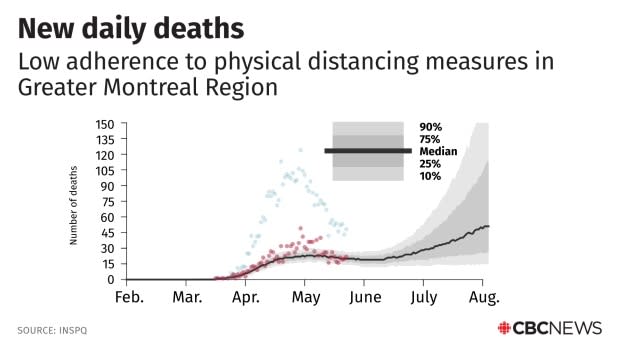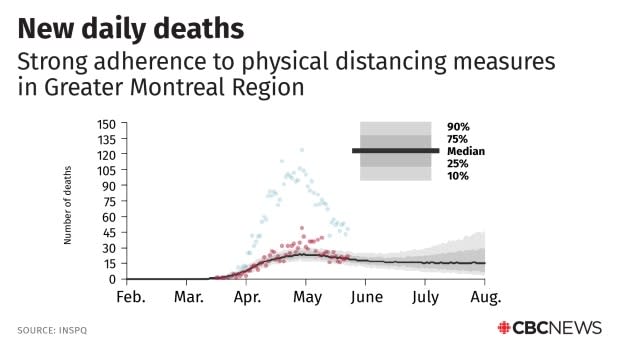Another spike in deaths likely unless Montrealers obey public health guidelines, researchers predict
If Montrealers get lazy about following public health guidelines, the metropolitan area could see a dangerous spike in hospitalizations and deaths from COVID-19 by July, according to the latest projections by government-affiliated experts.
The projections also suggest that if, on the other hand, a large majority of Montrealers continue to adhere to the guidelines — such as keeping two metres apart and wearing masks — it is possible to contain the spread of the virus while resuming some economic activities.
Researchers linked to Quebec's public health research institute, the INSPQ, presented their findings to reporters in an online briefing Wednesday afternoon, after sharing them with government officials earlier this week.
In the briefing, the researchers noted that since early May, there has been a sharp decrease in the numbers of hospitalizations and deaths in Montreal, including residents of long-term care centres.

But consolidating those gains as the city reopens retail stores and allows small gatherings will depend on widespread adherence to the public health guidelines that political leaders and public health authorities have been advocating for weeks.
"What we see in the projections is that if we are quite compliant with the measures, the situation will stay under control," said Gaston De Serres, an INSPQ epidemiologist who was part of the research team.
How many people are you in contact with each day?
The projections are based on mathematical models that estimate the average number of contacts people have in a day in which disease transmission is possible, i.e., when people are less than two metres apart.
Before the pandemic, they estimate, we interacted with an average of 12.2 people per day. During the lockdown period, which began in mid-March, that figure was reduced to 4.5 people per day.
They estimate that if Quebecers completely ignore the public health guidelines as the lockdown ends, average daily contacts will increase to eight.

With 50 per cent compliance to the guidelines, the figure drops to six per day. At 100 per cent compliance, it drops back down to 4.5 contacts per day.
A reopened Montreal, where people are only 50 per cent compliant, is likely to lead to dangerous scenarios for the health-care system, according to the INSPQ model predictions.
By August, new hospitalizations could reach 200 per day, according to one median estimate. Deaths could spike again, ranging anywhere from 50 to 150 per day.
"A return to the level of contacts we had before the pandemic can't be considered at the moment," the researchers concluded.
"That's why individual and collective measures to prevent transmission are important."
Improvements in Montreal from 'dire' situation 3 weeks ago
The previous round of INSPQ projections was released in early May, when Montreal was at a critical juncture.
"We weren't sure if the number of new hospitalizations and deaths were at a plateau or if they were starting to decline," De Serres said of the situation at that time.

Those projections warned that there could have been catastrophic rise in deaths and hospitalizations, had the provincial government gone ahead with its initial plan to reopen elementary schools and stores in Montreal on May 18.
Premier François Legault eventually scaled back his reopening plans for Montreal. Stores did not open until earlier this week, and elementary school children in the greater Montreal region won't be back in the classroom until the fall.
In the meantime, deaths and hospitalizations have decreased in the Montreal area, easing the strain on the health-care system.
"The situation is not as dire as it seemed three weeks ago," De Serres said.
The new INSPQ projections also examined the situation outside the greater Montreal area, where stores and elementary schools have been open for several weeks.
Hospitalizations and deaths could rise in those regions, too, if guidelines aren't widely respected. However, the danger of a critical spike isn't as great, given that transmission rates are lower.


